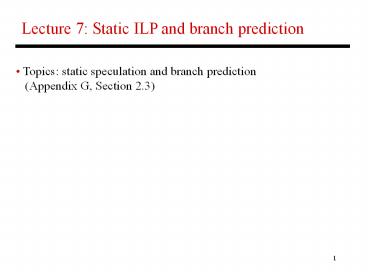Lecture 7: Static ILP and branch prediction - PowerPoint PPT Presentation
Title:
Lecture 7: Static ILP and branch prediction
Description:
to ensure that an exception is raised at the correct point ... Note that a speculative instruction needs a special opcode. to indicate that it is speculative ... – PowerPoint PPT presentation
Number of Views:45
Avg rating:3.0/5.0
Title: Lecture 7: Static ILP and branch prediction
1
Lecture 7 Static ILP and branch prediction
- Topics static speculation and branch prediction
- (Appendix G, Section 2.3)
2
Support for Speculation
- In general, when we re-order instructions,
register renaming - can ensure we do not violate register data
dependences - However, we need hardware support
- to ensure that an exception is raised at the
correct point - to ensure that we do not violate memory
dependences
st br ld
3
Detecting Exceptions
- Some exceptions require that the program be
terminated - (memory protection violation), while other
exceptions - require execution to resume (page faults)
- For a speculative instruction, in the latter
case, servicing - the exception only implies potential
performance loss - In the former case, you want to defer servicing
the - exception until you are sure the instruction is
not speculative - Note that a speculative instruction needs a
special opcode - to indicate that it is speculative
4
Program-Terminate Exceptions
- When a speculative instruction experiences an
exception, - instead of servicing it, it writes a special
NotAThing value - (NAT) in the destination register
- If a non-speculative instruction reads a NAT, it
flags the - exception and the program terminates (it may
not be - desireable that the error is caused by an array
access, but - the core-dump happens two procedures later)
- Alternatively, an instruction (the sentinel) in
the speculative - instructions original location checks the
register value and - initiates recovery
5
Memory Dependence Detection
- If a load is moved before a preceding store, we
must - ensure that the store writes to a
non-conflicting address, - else, the load has to re-execute
- When the speculative load issues, it stores its
address in - a table (Advanced Load Address Table in the
IA-64) - If a store finds its address in the ALAT, it
indicates that a - violation occurred for that address
- A special instruction (the sentinel) in the
loads original - location checks to see if the address had a
violation and - re-executes the load if necessary
6
Dynamic Vs. Static ILP
- Static ILP
- The compiler finds parallelism ? no
scoreboarding ? - higher clock speeds and lower power
- Compiler knows what is next ? better global
schedule - - Compiler can not react to dynamic events
(cache misses) - - Can not re-order instructions unless you
provide - hardware and extra instructions to detect
violations - (eats into the low complexity/power argument)
- - Static branch prediction is poor ? even
statically - scheduled processors use hardware branch
predictors - - Building an optimizing compiler is easier said
than done - A comparison of the Alpha, Pentium 4, and
Itanium (statically - scheduled IA-64 architecture) shows that the
Itanium is not - much better in terms of performance, clock
speed or power
7
Control Hazards
- In the 5-stage in-order processor assume always
taken - or assume always not taken if the branch goes
the other - way, squash mis-fetched instructions
(momentarily, - forget about branch delay slots)
- Modern in-order and out-of-order processors
dynamic - branch prediction instead of a default
not-taken - assumption, either predict not-taken, or
predict - taken-to-X, or predict taken-to-Y
- Branch predictor a cache of recent branch
outcomes
8
Pipeline without Branch Predictor
IF (br)
PC
Reg Read Compare Br-target
PC 4
In the 5-stage pipeline, a branch completes in
two cycles ? If the branch went the wrong way,
one incorrect instr is fetched ? One stall cycle
per incorrect branch
9
Pipeline with Branch Predictor
IF (br)
PC
Reg Read Compare Br-target
Branch Predictor
In the 5-stage pipeline, a branch completes in
two cycles ? If the branch went the wrong way,
one incorrect instr is fetched ? One stall cycle
per incorrect branch
10
Branch Mispredict Penalty
- Assume no data or structural hazards only
control - hazards every 5th instruction is a branch
branch - predictor accuracy is 90
- Slowdown 1 / (1 stalls per instruction)
- Stalls per instruction branches x mispreds
x penalty - 20 x 10 x
1 - 0.02
- Slowdown 1/1.02 if penalty 20, slowdown
1/1.4
11
1-Bit Prediction
- For each branch, keep track of what happened
last time - and use that outcome as the prediction
- What are prediction accuracies for branches 1
and 2 below - while (1)
- for (i0ilt10i)
branch-1 - for (j0jlt20j)
branch-2
12
2-Bit Prediction
- For each branch, maintain a 2-bit saturating
counter - if the branch is taken counter
min(3,counter1) - if the branch is not taken counter
max(0,counter-1) - If (counter gt 2), predict taken, else predict
not taken - Advantage a few atypical branches will not
influence the - prediction (a better measure of the common
case) - Especially useful when multiple branches share
the same - counter (some bits of the branch PC are used to
index - into the branch predictor)
- Can be easily extended to N-bits (in most
processors, N2)
13
Title
- Bullet

